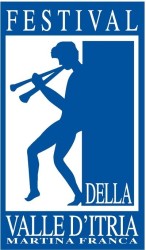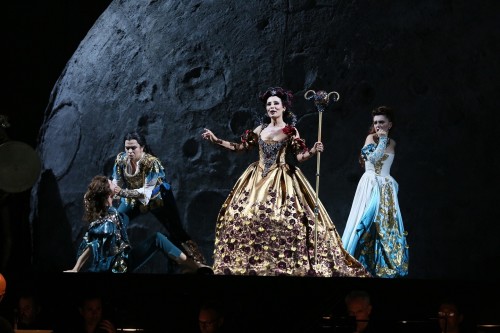
 Italy Festival della Valle d’Itria [2] – Vivaldi, Orlando Furioso: Soloists and Chorus of the Festival della Valle. I Barocchisti / Diego Fasolis (conductor), Palazzo Ducale, Festival della Valle d’Itria, Martina Franca, Puglia. 31.7.2017. (VV)
Italy Festival della Valle d’Itria [2] – Vivaldi, Orlando Furioso: Soloists and Chorus of the Festival della Valle. I Barocchisti / Diego Fasolis (conductor), Palazzo Ducale, Festival della Valle d’Itria, Martina Franca, Puglia. 31.7.2017. (VV)

Cast:
Orlando – Sonia Prina
Alcina – Lucia Cirillo
Angelica – Michela Antenucci
Bradamante – Loriana Castellano
Medoro – Konstantin Derri
Ruggiero – Luigi Schifano
Astolfo – Riccardo Novaro
Fattoria Vittadini dancers choreographed by Riccardo Olivier
Production (in collaboration with Fondazione Teatro La Fenice):
Director – Fabio Ceresa
Sets – Massimo Checchetto
Costumes – Giuseppe Palella
Lighting designer – Giuseppe Calabrò
This staging of Orlando Furioso is a co-production between the Festival della Valle d’Itria (now in its forty-third year) and the Fondazione Teatro La Fenice. A collaboration between Venice’s historic theatre and a festival which since its earliest days has explored the Baroque repertoire raises high expectations. They are fully met by an intelligent reading of the work and by its realisation by an exceptional cast and orchestra. The opera will be reprised at La Fenice in April 2018, but it is to be hoped that this production will travel beyond Italy.
Though still best known for his instrumental music, Vivaldi (1678-1741) composed numerous operas: ninety-four, by his own claim. Scholars have ascertained the existence of more than forty; sixteen complete ones survive. Orlando Furioso (1727) was among the first to be brought to the modern public’s attention in 1978 (the composer’s tercentenary) by Claudio Scimone in Verona, with Marilyn Horne in the title role.
The librettist Grazio Braccioli (1682-1752) was not wholly faithful to Ariosto (1474-1533), though accurately condensing the poet’s forty-six canti into an opera would have been a tall order. He respected their spirit and Renaissance ideals whilst emphasising the fantastical, magical elements which so appealed to Baroque tastes. The story was already familiar to contemporary audiences, and attracted them, with its blend of love, knights, battles and wondrous realms and creatures: a sorceress’s enchanted island, a magical ring, a hippogryph and a voyage to the moon. Unsurprisingly, it inspired operas by several composers of the era, including Handel (with Orlando, Alcina and Ariodante). Vivaldi had worked on two other versions before: one in 1713 by Ristori, on which he had collaborated; and his own Orlando Finto Pazzo of 1714. For the 1727 Orlando Furioso, he wrote mostly new music, but also re-employed extracts from Act II of the 1713 work and from the ending of the 1714 one.
Baroque opera presents production teams with a very particular set of choices, stemming fundamentally from the gulf between the social and cultural frameworks of audiences then and now. Here, the team gives us a balance of voices close to that of Vivaldi’s original cast, which will strike present-day audiences as unusual: all but one voice (Astolfo) are in the countertenor to soprano range; by contrast, the 1980 Dallas Opera production had Medoro sung by a tenor. As in other productions, we have a shortened libretto: it is printed in full in the festival programme, with the cuts highlighted.
These decisions are crucial to our experience of the work, as is the director’s interpretative key. Ariosto’s epic is characterised by a particular multiplicity of meanings (Calvino wrote repeatedly about it), which survives in Braccioli’s libretto. A production team cannot highlight all these meanings. What it can do is to focus on some, aiming to be faithful to the work’s authors whilst ‘speaking’ to present-day audiences. The collaboration between the festival and La Fenice has achieved this, with outstanding musical and dramatic results. The coherence between the director’s vision and the singing, orchestral playing, sets, lights and costumes is remarkable.
The director is Fabio Ceresa, assistant at La Scala from 2008 to 2014, and already with productions to his own name in Florence, Turin, Bari, Wexford and Seoul (including Orlando Finto Pazzo for Korean National Opera). Here he has realised on stage a vision based on the simultaneous trajectories and clash of opposites, eventually restored to harmony by wisdom. At one extreme, Orlando seems all-rational and immune to human passion; at the other, the sorceress Alcina seems all lust and immune to love. But they are similar, too: ‘their transformation,’ says Ceresa in his programme note, ‘ensues from a thwarted attempt to separate a couple of lovers’, Angelica and Medoro in Orlando’s case, and Bradamante and Ruggiero in Alcina’s. Angelica has escaped the advances of countless noblemen, including Orlando, but falls in love with and marries the simple soldier Medoro, triggering Orlando’s jealous rage. He thus becomes his very opposite, a frenzied beast who uproots anything in his path. Alcina has fallen in love too: with Ruggiero, whom she has taken prisoner; but his lover Bradamante shows up as a knight in armour to free him. In the end, Alcina’s magical world is shattered, while Orlando is restored to sanity when his mind is brought back from the moon by Astolfo, the Renaissance ideal of the man who can embrace the worlds of both the imagination and reality.
In the sets by Massimo Checchetto, designer at La Fenice since 2013, the ways in which opposites interact is highlighted by conjoining images of sky and sea: a hemisphere on stage doubles up as the moon in the sky and (on its reverse) Alcina’s world in the ocean. Giuseppe Calabró’s lighting transforms these from physical spaces to landscapes of the psyche. The costumes by Giuseppe Palella, who has repeatedly worked with Ceresa, help conjure a magical, exotic atmosphere and signal the characters’ progression. Ingenuous representations of the hippogryph and of a temple guardian contribute to the air of enchantment.
All these elements reflect the fluidity of the music, which shifts from the expression of one mood or emotion to another in quick succession. The structure of the opera lacks tension, due to discontinuities in the narrative arcs and character evolutions, but each of the arias and recitatives is highly dramatic in its own right. The melodic and harmonic lines are gloriously intertwined to convey feelings and landscapes. The orchestration couldn’t be in better hands than those of the Swiss conductor Diego Fasolis and the Baroque ensemble I Barocchisti, whose projects since 1998 include repeat collaboration with Cecilia Bartoli. They stand out for their spirited, nuanced rendition of the score on period instruments. The flute’s otherworldly solo and counterpoint (flautist: Stefano Bet) for Ruggiero’s ‘Sol per te, mio dolce amore’ deserve special mention.
A contralto with memorable low notes and a rich timbre, Sonia Prina tackles securely the demands of the title role, as Orlando moves from the self-assured to the plangent, the hallucinatory to the furious, with shifts of register and tone to match. The runs in arias like ‘Nel profondo, cieco mondo’ truly are a heroic feat. Mezzo Lucia Cirillo rises triumphantly to the challenges of Alcina’s wide expressive range. She combines impressive vocal technique with natural stage presence. Her warm tone is retained through flawless passaggi. The virtuosism of her final aria, ‘Anderó, chiameró dal profondo’ is breathtaking. Soprano Michela Antenucci’s Angelica gives us silvery coloratura, which in Acts II and III she endows with fuller resonance for thrilling, exquisitely beautiful singing. Countertenor Konstantin Derri is her lover Medoro. The voice is suitably light for the part, and his ‘Quel candido fiore’ lyrical, though the passaggi to the top notes can be abrupt. Loriana Castellano lends her creamy tone and fiery intensity to Bradamante. Vocal agility across the range combine with expressiveness for an excellent interpretation. Her beloved Ruggiero is sung by countertenor Luigi Schifano. His velvety tone and sensitive phrasing bring to the fore the beauty of ‘Piangeró sinché l’onda del pianto’ and ‘Sol per te mio dolce amor’. Baritone Riccardo Novaro combines poise and elegance with a warm, powerful tone and vocal agility, making for a thoroughly convincing Astolfo. The dancers of Fattoria Vittadini and the festival chorus provide solid support to the production.
Valeria Vescina
